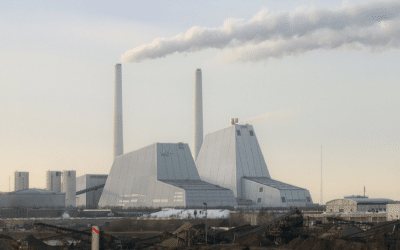Guest article by Martin Pigeon, Forest & Climate Campaigner (Bioenergy) with Fern
Stockholm Exergi’s ambitious plan to deploy a flagship Bioenergy with Carbon Capture and Storage (BECCS) facility at its Värtaverket biomass plant in Stockholm, Sweden, has stirred both excitement and scepticism. Promoted as a cutting-edge initiative to combat climate change, the project has secured substantial funding and high-profile endorsements. Fern’s new investigation, however, raises serious questions about its effectiveness, the climate and biodiversity impact, and its financial viability.
A promising climate fix?
The BECCS facility, slated to begin operations in 2027, aims to capture 800,000 tonnes of CO2 annually from biomass combustion. Supported by €180 million from the EU Innovation Fund, potential access to a €3 billion Swedish state aid scheme and a carbon credits contract with Microsoft, the project is being considered as a potential blueprint for negative emissions technology. EU Commission President Ursula von der Leyen hailed it as a “quantum leap in energy production,” positioning it as a cornerstone of the EU’s net-zero strategy.
The portrayal of BECCS as a climate saviour is common, due to its promise of carbon-negative energy. Its proponents argue that by burning biomass and capturing the resulting emissions for underground storage, it can offset atmospheric CO2 while providing energy. But critics contend, and our findings show, that the technology fails to deliver on its lofty claims.
The cracks in BECCS’ promise
Our analysis highlights several flaws in Stockholm Exergi’s plan:
- BECCS does not remove CO2 from the atmosphere, forests do: While EU rules consider biomass as zero-carbon in the energy sector, burning wood emits more CO2 per unit of energy than fossil fuels. All BECCS can do, therefore is reduce emissions from biomass burning, it does not remove atmospheric carbon directly. Atmospheric removals can only occur in this case through tree growth – something outside of company controls.
- Negative emissions are dependent on better forest management: Stockholm Exergi claims to source much of its biomass from “forestry residues,” but provides little information on the type and origin of the wood it burns. “Forestry residues” can include whole trees. With clear-cut forestry dominant in Swedish forestry, and high deforestation rates in Sweden’s remaining primary forests, there is likely to be increased atmospheric carbon as a result of burning wood from Sweden for decades to centuries. This undermines the possibility that this BECCS installation would ever achieve negative emissions through the regrowth of trees.
- Technical Hurdles: The proposed carbon capture technology, Hot Potassium Carbonate (HPC), remains unproven in the power sector. The projected 90% capture rate has not been reached by any Carbon Capture and Storage (CCS) installation anywhere, and the claimed 2% energy penalty from running the CCS installation would also be unheard of.
- Storage Shortage: The Northern Lights project, a key storage partner in Norway, has already committed all of its capacity to other projects. Stockholm Exergi has yet to secure an alternative, raising doubts about the feasibility of its long-term storage plans.
- High Costs: BECCS is very expensive and depends on policy support to be economically profitable.
A better path forward?
Fern’s report suggests that alternatives to BECCS could achieve greater climate benefits at much lower costs. Reducing Sweden’s annual wood harvest by just 0.8% would sequester as much CO2 as Stockholm Exergi’s project, with added benefits for biodiversity, water quality, and recreation. A 10% reduction could remove over 12 times more CO2 annually.
Furthermore, protecting and restoring ecosystems offers a proven method for atmospheric carbon removal, unlike BECCS.
Risk of fossil fuel alignment
BECCS risks perpetuating fossil fuel dependence. Captured CO2 is often used for Enhanced Oil Recovery (EOR), a process that boosts oil production. While Stockholm Exergi has committed to not selling its captured CO2 for EOR, enforcing such a commitment is likely to be challenging.
The report also warns of double-counting risks, where carbon credits generated by BECCS could be claimed by both national governments and international voluntary carbon offset markets, undermining climate targets.
Finally, even if negative emissions were to be achieved and carbon credits generated, Stockholm Exergi’s polluting customers would remain free to offset their fossil emissions with these credits, cancelling out the possible climate benefit.
Policy at a crossroads
Despite its flaws, BECCS remains central to EU climate models. The Carbon Removals Certification Framework (CRCF), adopted by the EU in 2024, might incentivise BECCS deployment with erroneous draft carbon accounting methodologies. The risk is real that activities that are a mere transfer of carbon between the biogenic and the geological carbon pools, or even additional emissions, will end up being certified as carbon removals under the CRCF. This will come at the expense of forests, effective climate action and proven solutions, such as energy efficiency, cleaner sources of renewable energy and forest restoration.
Conclusion: probably more a costly diversion than a climate solution
Neither Stockholm Exergi nor BECCS are going to be our climate saviours. Policymakers must therefore prioritise measures that deliver immediate, tangible climate benefits. With emissions reductions urgently needed, the focus must shift from costly experiments to scalable, sustainable solutions.
For more information on this issue, you can read Fern’s new investigation on Stockholm Exergi’s BECCS project and Geoengineering Monitor’s latest technology update on BECCS.



